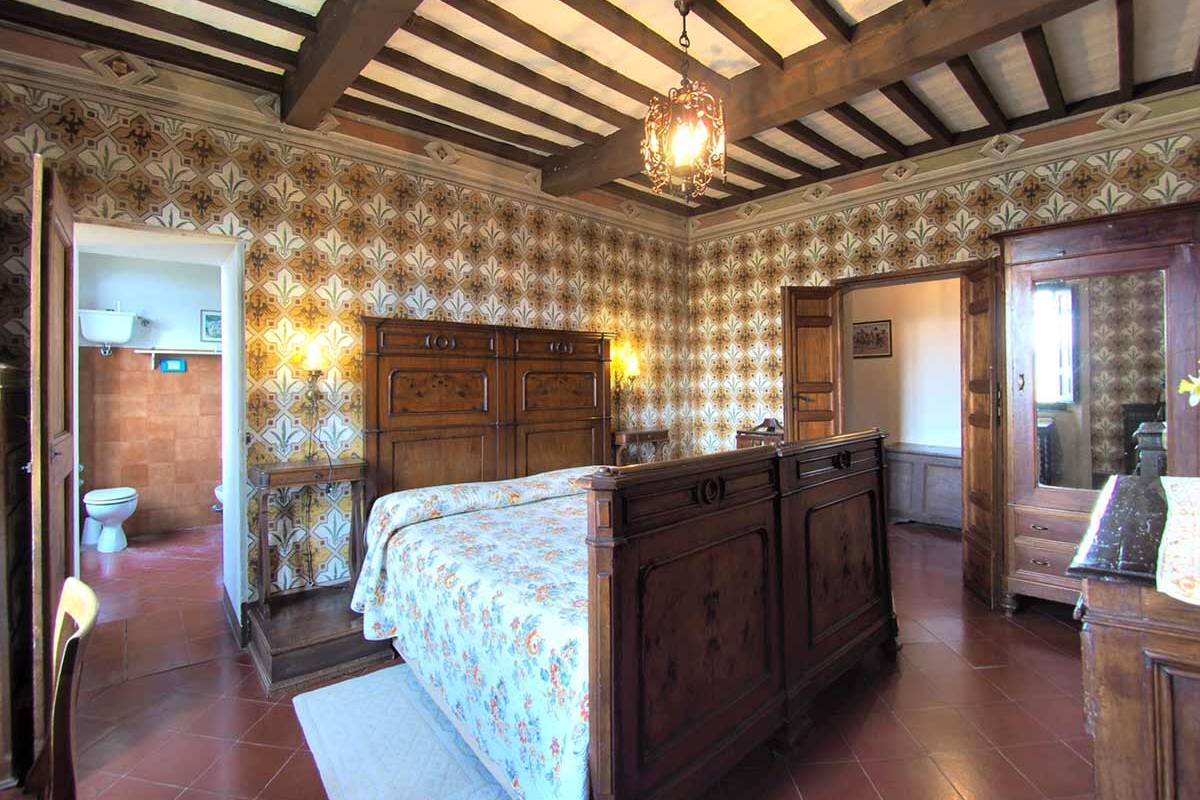Torre del Vescovo
160 m², per 6/7 persone
3 camere
, 3 bagni
Il castello vero e proprio è diviso in due ali: noi viviamo in una metà mentre Torre del Vescovo è l'altra ala. E' su due piani e include la torre di guardia. Vi si accede con una scala esterna di pietra dalla corte principale.
Al piano terreno, la sala principale ha le pareti affrescate e il soffitto con travi a vista: include un'area pranzo e un'area soggiorno con un un vecchio pianoforte a muro e la televisione. C'è poi una cucina separata, con lavastoviglie e lavatrice. Sempre al piano terra c'è uno dei tre bagni della casa (con doccia). Dalla sala principale si scende nel giardino esclusivo del Vescovo con un tavolo per mangiare all'aperto sotto una pergola coperta di glicine.
Al secondo piano si trovano: la camera da letto principale (la Camera delle Aquile), con pareti dipinte, mobili di antiquariato, letto matrimoniale e bagno privato (doccia su vasca); due altre camere da letto, una con due letti singoli e l'altra con un letto matrimoniale che può essere separato in due letti singoli; e un bagno con doccia.
Dalle scale che portano al piano superiore si può accedere ad una terrazzina con vista sul giardino e la vallata e da lì a uno studiolo ricavato nella torre di guardia. Abbiamo trasformato questo studiolo in una cameretta singola. Da una delle camere da letto del piano superiore invece si accede alla scala per salire sulla cima della torre.
Dalla corte principale di Montalto si sale una scala in pietra e si arriva alla corte superiore ombreggiata da un tiglio secolare. Da qui si accede sia a Torre del Vescovo che alla torretta San Martino (appartamento per 2 persone). Si possono affittare Torre del Vescovo e San Martino insieme (per un totale di 8/9 persone) e avere l'uso in esclusiva della corte sotto il tiglio.
Condizioni di affitto
Il Castello di Montalto non è un albergo. L’orario di check-in è fra le 16:00 e le 19:00. Vi preghiamo di avvisarci se non riuscite ad arrivare entro le ore 19:00: ci organizzeremo in modo da potervi accogliere anche la sera. Il check-out deve essere entro le 10:00.
Richiediamo un soggiorno minimo di 3 notti. Si accettano prenotazioni per soggiorni più brevi a 10 giorni dalla data di arrivo, secondo disponibilità. Contattateci in proposito.
Una caparra del 30% dell'affitto totale deve confermare ogni prenotazione. Il saldo dell'affitto è dovuto un mese prima dell'arrivo. Vi invitiamo a leggere e accettare i nostri termini di disdetta qui di seguito prima di effettuare la prenotazione.
Accettiamo pagamenti tramite carta di credito Visa, Mastercard o tramite PayPal. Usando il nostro sistema di prenotazione online potrete inserire i vostri dati in tutta sicurezza. Oppure contattateci e vi daremo istruzioni su come effettuare il pagamento online.
I prezzi degli affitti sono da considerarsi per casa, indipendentemente dal numero degli occupanti. Secondo la legge italiana non possiamo superare il numero massimo autorizzato di ospiti per ogni casa. Un lettino supplementare può essere aggiunto a pagamento (dove lo spazio lo consente) solo per bambini fino a 12 anni di età.
La tassa di soggiorno è di € 2,00 per persona, al giorno, per i primi 7 giorni. Non si applica ai bambini al di sotto dei 13 anni.
I cani sono ammessi (ma solo in alcune case) al costo aggiuntivo di € 50. Vi preghiamo di chiedere in anticipo.
Termini di disdetta
Le prenotazioni vengono confermate con una caparra pari al 30% dell'importo totale dell'affitto. La caparra non è rimborsabile.
Il saldo dell'affitto è dovuto un mese prima dell'arrivo e non può essere restituito dopo tale data.
Offriamo prezzi e termini di disdetta speciali per gruppi di più di 15 persone o per matrimoni e altri eventi speciali: contattateci per saperne di più.
L’affitto delle nostre case include:
- lenzuola e asciugamani (è previsto un cambio settimanale per affitti lunghi)
- internet wi-fi
- gas, elettricità, acqua
- riscaldamento
- stoviglie e attrezzatura da cucina
- pulizie finali (ma vi chiediamo di lasciare pulita la cucina e di portare via la spazzatura)
Inoltre è incluso l'accesso alle seguenti aree comuni:
- piscina
- area barbecue
- campo da tennis
- zona lavanderia
- bocce, pingpong e biliardino
- sala lettura
- sala pianoforte
- sala TV
Servizi aggiuntivi su richiesta
- Prima colazione: dal 15 maggio al 15 ottobre è possibile richiedere una prima colazione a buffet a € 14 a persona al giorno Sconto del 50% per bambini al di sotto di 8 anni.
Include: torte, pane, salumi e formaggi locali, uova sode, cereali, muesli, frutta fresca, yogurt, miele, marmellate, caffè, latte, succo d’arancia.
- Cambio biancheria: € 10 a persona
- Pulizia giornaliera: a seconda della dimensione della casa
- Asciugamani per la piscina: € 2,50 al pezzo
- Letto extra (per bambini di non più di 12 anni): € 80 per l’intero soggiorno
- Lettino per bambini sotto i 3 anni: € 15 per l’intero soggiorno
- Asciugatrice a gettone nell’area lavanderia
- Servizio completo (pulizia giornaliera e cambio infrasettimanale di biancheria): a seconda della dimensione della casa
Si possono avere molti altri servizi speciali su richiesta, come pasti caldi a domicilio, corsi di cucina, visite guidate, trasporto individuale o di gruppo, equitazione, tour in bicicletta e molto altro ancora.
Offriamo anche assistenza nell’organizzazione di matrimoni o altri eventi speciali: contattateci per ulteriori informazioni.











